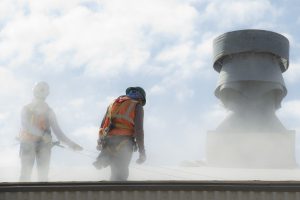TPO vs EPDM vs PVC
There are so many different roofing options readily available to property owners today. When making a choice, there are also so many factors to consider – aesthetics, durability, resistance, cost, and many others.
One of the more popular options in the market right now is the use of single-ply membrane systems, such as TPO, EPDM, and PVC roofing. These are all different materials which are commonly used for single-ply roofing on commercial properties. Recently, there have been a spike in the number of homeowners using this type of roofing as well.
Why?
Read on to find out the specific properties, advantages and disadvantages of these materials.

EPDM Roofing
EPDM, ethylene propylene diene monomer, is a synthetic rubber material that is commonly used in roofing applications, as well as in other outdoor applications, due to its high tensile strength, durability, flexibility, and high resistance to varying weather conditions. EPDM roofs can last decades with minimal maintenance because regular day-to-day and seasonal temperature changes do not cause it to wear out quickly. The material does not easily change its shape when exposed to hot or cool temperatures. It has a thermoset property that enables it to retain its shape in these conditions.
This material is typically available in sheet rolls which are relatively easy to install. However, when installing EPDM roofing, we would not recommend it as a DIY project. For this type of roofing, getting a professional to do it will ensure quality workmanship. It adheres to the roof structure with high strength adhesives and tapes. Aside from being durable, EPDM rubber is also waterproof. Thus. you also create a water and moisture barrier between the environment and your home.
Aside from those properties, another advantage of an EPDM roof is that it is highly impact resistant. It creates an effective defense system against hailstorms, windblown debris, and other materials that could potentially damage your roof.
TPO and PVC
Aside from EPDM, other single-ply membrane options include TPO and PVC materials. TPO. which is thermoplastic polyolefin, and PVC, which is polyvinyl chloride, are both materials that change their shape when there is a change in temperature. Aside from this, another thing that these materials have in common is that they are both white or reflective in appearance.
However, despite not having the thermoset property that EPDM roofing has, these materials are just as durable as EPDM roofing. These materials also offer another set of advantages that are not provided by EPDM roofing systems.
A major benefit to using TPO or PVC roofing is that it provides resistance against certain chemicals and bacteria. Things such as oils or animal fats, which could end up damaging other roofing materials, will not damage your TPO or PVC roof.
The white color of this material is also another benefit. Aside from being aesthetically pleasing, the material also adds a cooling effect to your roof. When properly installed, your TPO or PVC roof will be able to control temperatures around the building, as well as inside it. This is owed to the naturally reflective property of the material which also makes it more energy efficient than the black EPDM alternative, especially during the summer time.
EPDM vs TPO vs PVC
After learning about these different materials, you’re probably wondering which one is the better option for your property. However, as with any other decision anyone makes, the best option is not always objective. In this case, the best roofing option is completely dependent on your property as well as many other factors.
When you take into consideration the inherent properties presented by these different materials, you might be able to pick out which material is the best for you. However, we are also here to help. If you need expert advice on what the best roofing material for your property is, we are readily available to help you out. Our years of expertise and experience in roofing will help us guide you towards the right decision.
Choosing the best roof for your commercial building involves careful consideration and decision-making. Aside from the many options available – many of which you probably have no clue about – you also need to factor in things like typical weather conditions which your property is often exposed to, the building’s design and architectural style, and even what your business does or makes.
Single-ply membrane systems are great for a range of business and building types, but you need to consult an expert commercial roofing resource like Wade Exteriors to get the best performance from your roof.

